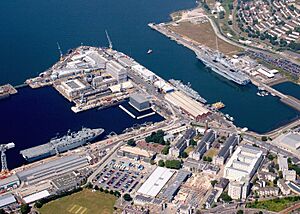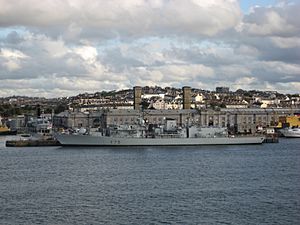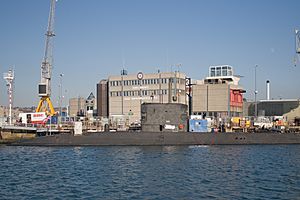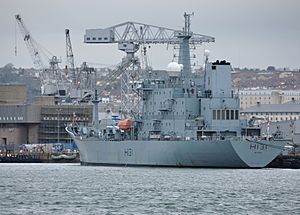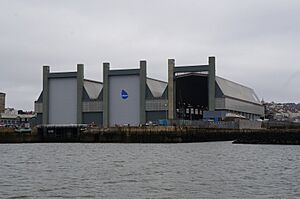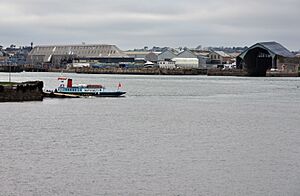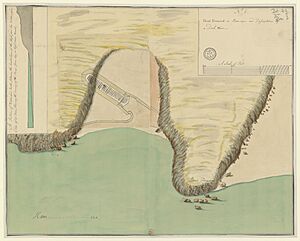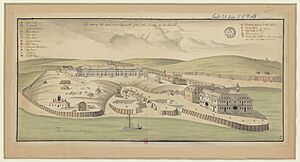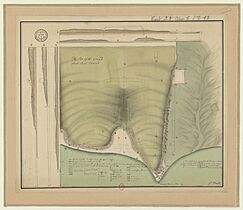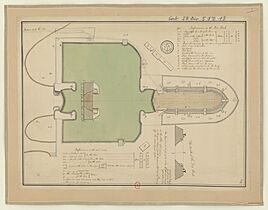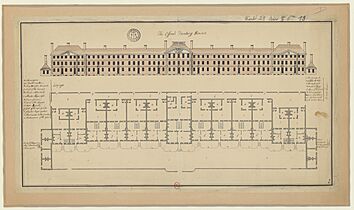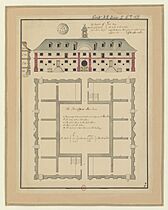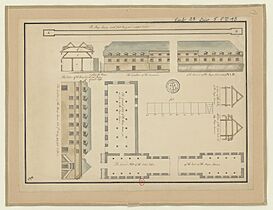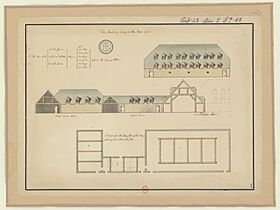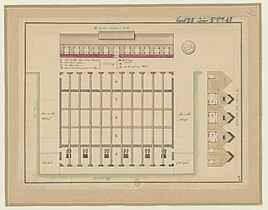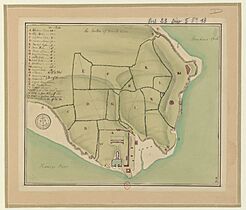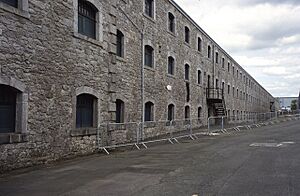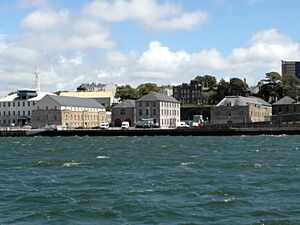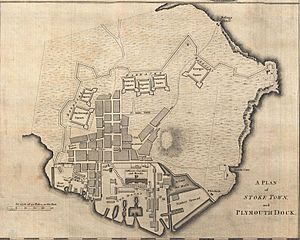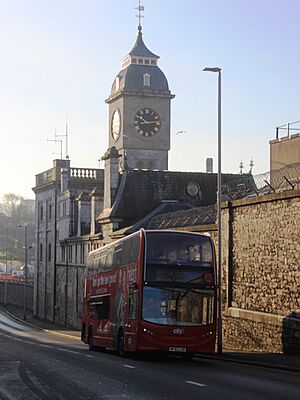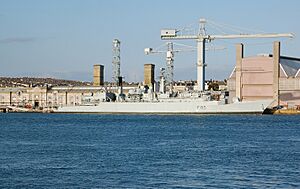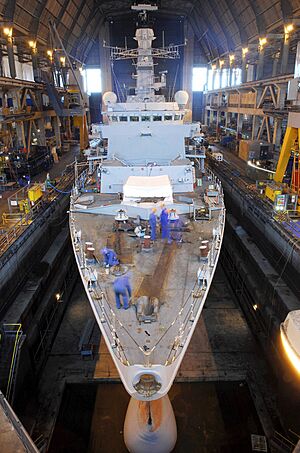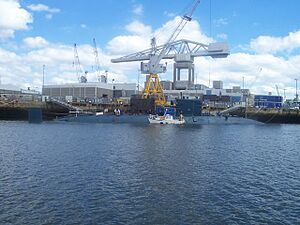HMNB Devonport facts for kids
Quick facts for kids HMNB Devonport
|
|
|---|---|
| Plymouth, Devon in England | |
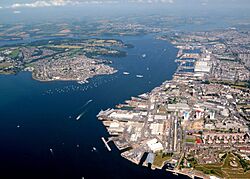
Aerial view of HMNB Devonport: the South Yard (in the foreground) dates from 1692, since when the dockyard has expanded northwards (towards the top of the picture).
|
|
|
Location in Devon
|
|
| Coordinates | 50°22′58.8″N 04°10′58.8″W / 50.383000°N 4.183000°W |
| Type | Naval base |
| Area | 263 hectares (650 acres) |
| Site information | |
| Owner | Ministry of Defence (Navy Command) |
| Operator | Royal Navy |
| Controlled by | Naval Base Commander, Devonport |
| Condition | Operational |
| Site history | |
| Built | 1691 |
| In use | 1691 – present |
| Events | Plymouth Blitz (1941) |
| Garrison information | |
| Garrison | Devonport Flotilla |
His Majesty's Naval Base, Devonport (HMNB Devonport) is one of the three main bases for the Royal Navy in the United Kingdom. It is the only place where the Royal Navy's nuclear submarines are repaired and refuelled. Located in Devonport, Plymouth, England, it is the largest naval base in Western Europe.
This base started as a Royal Navy Dockyard in the late 1600s. It was designed by Edmund Dummer to fix and maintain warships. He built one of the first stone dry docks in the world there. Over the years, the base grew a lot.
Historically, the yard also built ships. More than 300 naval vessels were made here. The last one was HMS Scylla, launched in 1968. The yard was called HM Dockyard, Plymouth until 1843. Then it became HM Dockyard, Devonport. Later, the name changed to 'Naval Base'.
Today, HMNB Devonport is home to the Devonport Flotilla. This is a group of Royal Navy ships based here. FOST, which trains the Fleet, is also located here. The Royal Navy's Amphibious Centre of Excellence is at RM Tamar. Even though shipbuilding stopped, ships are still repaired and maintained here. This work is done by a private company called Babcock International Group. They run the Devonport Royal Dockyard.
The base also provides housing and support for naval staff. The Royal Naval Barracks, built in 1889, was first called HMS Vivid. It was renamed HMS Drake in 1934. Since the early 2000s, the name HMS Drake covers the whole Naval Base. HMS Vivid is now Plymouth's Royal Naval Reserve unit.
Contents
The entire Naval Base covers about 650 acres (2.6 square kilometres). It has four miles (6 km) of waterfront. There are 25 places for ships to dock, five large water areas (basins), and 14 dry docks. A dry dock is a place where a ship can be moved out of the water for repairs. The base employs 2,500 military and civilian staff. It helps about 400 local businesses and adds about 10% to Plymouth's income. The base commander is currently Brigadier Mike Tanner, the first Royal Marine officer in this role.
Devonport Flotilla Ships
In 2009, the Ministry of Defence decided on the future roles of the three naval bases. Devonport would no longer be a base for attack submarines. These moved to Faslane. The Type 45 destroyers would be based at Portsmouth. However, Devonport remains the home for the amphibious fleet, survey ships, and more than half of the frigate fleet. HMS Triumph, the last Trafalgar-class nuclear-powered submarine, is also based here. In 2018, it was announced that all new Type 26 frigates would be based at Devonport.
Ships based at Devonport are part of the Devonport Flotilla. They include:
Amphibious Assault Ships
- HMS Albion (a landing platform dock, currently in reserve)
- HMS Bulwark (a landing platform dock, also in reserve)
Type 23 Frigates
- HMS Northumberland
- HMS Richmond
- HMS Portland
- HMS Somerset
- HMS Kent
- HMS Sutherland (currently being refitted)
- HMS St Albans (doing sea trials after refit)
Trafalgar-class Submarine
- HMS Triumph (returned to sea in 2022 after refit)
Survey Ships
- HMS Magpie
- HMS Scott
Antarctic Patrol Ship
- HMS Protector
Aviation Support Ship
- RFA Argus (used for support in operations)
Fast Fleet Tankers
- RFA Wave Ruler (in reserve)
- RFA Wave Knight (in reserve)
Other Units at Devonport
- Fleet Operational Standards and Training (FOST)
- Hydrographic, Meteorological & Oceanographic Training Group (trains people for sea mapping and weather)
- 2 x Sea-class 15-metre survey/hydrography vessels (Merlin and Fantome)
- HQ Amphibious Task Group (manages amphibious operations)
- HMS Vivid RNR (Royal Naval Reserve unit)
- RM Tamar/47 Commando (Raiding Group) Royal Marines (Royal Marines base)
- Various Landing Craft Training and Assault Squadrons
- Hasler NSRC (Naval Service Recovery Centre) & Hasler Company Royal Marines (helps injured service members)
- Southern Diving Group RN (bomb disposal and diving unit)
- 1 × Sea-class 15-metre diving support boat (DSB Vulcan)
- Ministry of Defence Police (provides security)
Dockyard Facilities
Babcock's Devonport Royal Dockyard is next to the Naval Base. It provides support for submarines, surface ships, and their systems. They offer maintenance for ships that are in service. Dry docks are used to repair, refit, and update warships. Special workshops fix complex parts.
In the 1970s, Devonport became a refit base for nuclear submarines. The Submarine Refit Centre opened in 1981. Since 2002, Devonport has been the only place where Royal Navy nuclear submarines are refitted.
Babcock started a ten-year project in 2022 to upgrade its facilities. This project will improve the docking and berthing areas for nuclear ships. It will make sure the base can handle new and existing types of submarines and frigates.
Nuclear Submarine Decommissioning
In 2018, thirteen nuclear submarines that were no longer in service were stored at Devonport.
- HMS Conqueror
- HMS Courageous (preserved as a museum ship)
- HMS Sceptre
- HMS Spartan
- HMS Splendid
- HMS Sovereign
- HMS Superb
- HMS Tireless
- HMS Torbay
- HMS Trafalgar
- HMS Turbulent
- HMS Valiant
- HMS Warspite
The process of taking these submarines out of service has been slow. The Ministry of Defence has faced criticism for the high costs of storing them.
South Yard (Freeport)
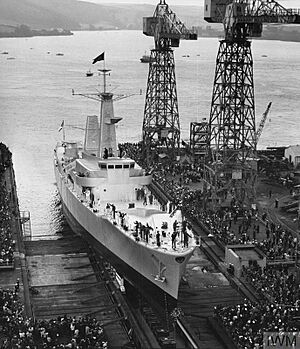
Some parts of the South Yard, the oldest section of the Naval Base, are no longer used by the Ministry of Defence. Its historic slips were once used for shipbuilding. In 2012, the southernmost part was sold to a private company. In 2014, the northern part was leased to Plymouth City Council for a regeneration project. Other areas are leased to Babcock. In 2022, most of the South Yard became part of Plymouth's Freeport.
Princess Yachts
In 2012, Princess Yachts bought 20 acres (0.08 square kilometres) at the southern end of the site. They now build large luxury yachts, called 'superyachts', there. The company sees itself as continuing the tradition of boat building in the dockyard. Old classic vessels are also repaired here by Stirling & Son.
Oceansgate
In 2014, a plan was announced to develop more of the South Yard into a 'marine industries hub'. This area was renamed Oceansgate. It focuses on marine science and technology businesses. Phase 1 was finished in 2018, and Phase 2 in 2021. These areas have new offices and business units. Phase 3, which includes old dry docks and historic buildings, is also being developed.
The Devonport Naval Heritage Centre, a museum run by volunteers, is located in the Oceansgate area.
MOD Areas
Most of the South Yard still belongs to the Ministry of Defence (MOD). This area is largely used by MOD contractors and has security restrictions. No. 4 Slip has been recently updated for use with landing craft.
Freeport Status
Since December 2022, the South Yard is one of three 'freezones' in the Plymouth and South Devon Freeport. Being a Freeport offers tax benefits for businesses there. The plan is for the South Yard Freeport to focus on marine and defence development. It aims to be a center for innovation. Future plans include expanding Oceansgate and building a new factory for Princess Yachts.
The dockyard started in the 1600s around what is now called the South Yard. It grew in stages over 250 years. Key periods of growth included:
- Building Plymouth Dock and Yard (1692-1698).
- Adding Morice Ordnance Yard (1719-1720), which later became part of the dockyard.
- The Great Rebuilding (1760-1790), expanding the dockyard to the south.
- Building Keyham Steam Yard (1844-1865) to the north.
- The Keyham Extension (1896-1907), which doubled the size of the Keyham yard.
- Taking over nearby land after World War II for future expansion.
- Reclaiming Weston Mill Lake (1972-1979), now the northernmost part of the base.
Early Beginnings
In 1689, King William III wanted a new dry dock west of Portsmouth. This was to support ships patrolling the western English Channel. Edmund Dummer, the Navy's surveyor, found a good spot on the Hamoaze (part of the River Tamar) near Stoke Damerel. In 1690, a contract was signed to build a dock.
The project grew quickly. The King wanted a larger dock for big ships. The Navy also needed a basin to protect the dock entrance. In 1692, the Admiralty decided to build a full Royal Navy Dockyard there. This was the start of Plymouth (later Devonport) Royal Dockyard.
Dummer designed a stone-lined wet dock and the first successful stepped stone dry dock in Europe. His docks were stronger and safer than older wooden ones. They also made it easier for workers. He also improved the dock gates.
Dummer designed the dockyard to be very efficient. He put a central storage area (the Great Storehouse) near the basin. Other buildings were placed logically around the yard. The southern edge had a 'double' rope-house for making ropes. The anchor smithery was placed safely to the north. On a hill, he built houses for senior dockyard officers. Work on the dockyard finished by 1698. A chapel was added two years later.
Many of these original buildings were rebuilt over time. Dummer's first wet dock and dry dock were rebuilt in the 1840s. They are now known as No. 1 Basin and No. 1 Dock. Most of the officers' houses were destroyed in the Blitz during World War II. Only one part of the original terrace still stands. It is the oldest surviving building in any royal dockyard.
- Plans and elevations from Edmund Dummer's 1694 survey of the building of the dockyard
-
The Barton of Mount Wise: the dockyard and surrounding fields
South Yard Development
The South Yard is where the dockyard first began. More docks and slipways were added in the early 1700s. The number of workers grew from 736 in 1711 to 2,464 in 1730. A small area was also filled in to create a mast pond for storing timber.
The Great Rebuilding

From the 1760s, a major expansion took place. The yard gained five slipways, four dry docks, and a basin. New slips were built on new ground to the south. One slipway (No.1 from 1774) still exists today. It has a rare timber cover from 1814. Another similar cover stands over the former No.5 Slip.
A rocky hill was cut away to make space for the expansion. The old ropehouse was removed, and a new one was built. A canal called the Camber was created, leading to a boat basin. A new smithery was built in 1776 with 48 forges. This building still stands and is the oldest smithery in any royal dockyard.
The largest building from this time was a double-quadrangular storehouse from 1761. It was destroyed during the Plymouth Blitz in World War II. Many other historic buildings were also lost during the war.
Later Changes
The dockyard suffered a big fire on September 25, 1840. Two ships, HMS Talavera and Imogene, were destroyed. The fire caused a lot of damage, estimated at £150,000. It was stopped by tearing down nearby buildings.
The South Yard continued to be updated for new shipbuilding technology. Docks and slips were expanded in the 1800s. The mast ponds were filled in to make room for a new, larger No. 3 Slip. This slip was designed for building huge ships called dreadnoughts. In 1912, No. 3 Slip was extended to 752 feet (229 metres) for ships like HMS Warspite.
The South Yard was heavily damaged by bombs during World War II. By 1942, 85% of its buildings were badly damaged or destroyed.
Morice Yard (New Gun Wharf)
The Board of Ordnance was responsible for providing ships' weapons. In 1719, they built a new gun wharf called Morice Yard. It was located north of the main Dockyard. Morice Yard had its own workshops, workers, and storage. Gunpowder was stored here, which worried local residents. Later, gunpowder magazines were moved further north.
In 1855, the Board of Ordnance was abolished. The War Office took over Morice Yard. It remained separate from the dockyard until 1941, when it became part of the larger complex. Most of the original buildings at Morice Yard survived the Blitz. Today, Morice Yard is still part of the Naval Base. In 2022, it became the headquarters for Surface Fleet Command.
The Devonport Lines
In 1758, a law allowed for building defenses around the dockyard. These defenses, called the Devonport Lines, were a bastion fort. They had an earthen rampart with a wide ditch. The lines ran from the River Tamar, surrounding the dockyard and town. They were about 2,000 yards (1,800 metres) long. There were four bastions and three gates. After 1860, these defenses were replaced by new forts around Plymouth.
Keyham (the North Yard)
In the mid-1800s, all royal dockyards had to adapt to new technologies like steam power and metal ships. Devonport built a separate steam yard at Keyham in 1864, north of Morice Yard. A tunnel connected the new yard to the old one.
Keyham had two large basins and three dry docks. No. 3 Basin led to a huge manufacturing complex called the Quadrangle. This building housed foundries, forges, and workshops. It is still standing and is a Grade I listed building. It is considered one of the most important engineering buildings in the country.
In the 1970s, three dry docks (Nos. 5, 6, and 7) were rebuilt and covered. They became the Frigate Refit Complex. They are still used today, along with the Quadrangle building, which continues to make parts for ships.
Keyham Extension
In 1895, Keyham Steam Yard was expanded to fit larger warships. By 1907, Keyham, now called the North Yard, had more than doubled in size. It gained two more basins (No. 4 and No. 5) and three more dry docks (Nos. 8, 9, and 10). These docks could fit the biggest warships of the time. The northern end of the site was used as a large coaling yard for steam-powered ships.
In the 1970s, a new Fleet Maintenance Base was built. A new Submarine Refit Complex was also created. It opened in 1981. Two new dry docks (Nos. 14 and 15) were built for nuclear submarines. A huge 80-ton cantilever crane was installed to lift nuclear cores from submarines.
In 1993, the Submarine Refit Centre was upgraded. Devonport became the Royal Navy's only nuclear refit yard. Dry docks Nos. 9 and 10 were strengthened for the larger Vanguard-class submarines. This work was finished in 2002.
In 2011, the MOD sold much of the North Yard to Babcock. This includes Basins No. 2 and No. 5 and their dry docks.
Weston Mill Lake
North of No. 5 Basin, land around Weston Mill Lake was filled in during the 1970s. This area was then used for frigate berths. It is now where the Navy's amphibious warfare ships are based. In 2013, a new Royal Marines base, RM Tamar, opened here. It serves as headquarters for 1 Assault Group Royal Marines. Weston Mill Lake and its surrounding areas are still owned by the MOD.
Before the late 1800s, sailors whose ships were being repaired lived in old floating ships called hulks. An onshore barracks was built north-east of the North Yard and finished in 1889. It was named "HMS Vivid". It could house 2,500 sailors and officers.
The tall clock tower was built in 1896. It had a clock and bell. The barracks expanded in 1898 to hold another 1,000 men. More buildings were added in the early 1900s, including St Nicholas's Church. This area has fourteen listed buildings.
The barracks were renamed HMS Drake in 1934. In the early 2000s, the name HMS Drake was extended to cover the entire naval base. The barracks area is now called the Fleet Accommodation Centre. It is still owned by the MOD.
Goschen Yard and Post-War Development
The civilian streets around Devonport were heavily bombed during World War II. After the war, some damaged streets near the dockyard were not rebuilt. Instead, they were taken over by the Admiralty for future expansion. An area called Goschen Yard was created, where factories and workshops were built.
In 2005, a large part of Devonport's historic town center, which had been used as a naval stores yard, was released from MOD ownership. This area has since been redeveloped with housing. Some surviving buildings, like the old Market Hall, have been restored.
Heritage and History
Listed Buildings
Despite the damage from World War II, the South Yard still has four scheduled monuments and over thirty listed buildings and structures. Some of these, like the 18th-century South Sawmills and South Smithery, are in need of repair.
Many of these historic buildings are now owned by Princess Yachts. This includes the Grade I listed East Ropery and the covered No. 1 Slip. The 'King's Hill Gazebo' was built to remember a visit by King George III. Other listed buildings are in the Oceansgate area, including dry docks and buildings used by the Naval Heritage Centre.
Other parts of the yard also have many listed buildings. There are fourteen in the Barracks area (HMS Drake), thirteen in the Morice Yard, and seven in the North Yard. These include the Grade I listed Quadrangle workshops, which are now managed by Babcock International.
The Devonport Naval Heritage Centre is a maritime museum in the historic South Yard. It is run by volunteers and is open on certain days. The nuclear-powered submarine HMS Courageous, which was used in the Falklands War, is preserved here as a museum ship. However, it is currently closed to visitors. The National Museum of the Royal Navy plans to create a larger visitor attraction in Devonport. This will include a new museum and the preserved HMS Courageous.
Safety at the Base
Devonport is a nuclear submarine refit base. The Office for Nuclear Regulation (ONR) closely monitors safety here. In 2013, the base was put into special measures to improve safety. This was due to concerns about older facilities and resources. The base has been working to upgrade its facilities to meet modern safety standards.
Nickname
Sailors and marines often call the Naval base at Devonport "Guzz" (or "Guz"). One idea is that this comes from the word guzzle, meaning to eat or drink a lot. This might refer to eating cream teas, a local treat. Another idea is that "GUZZ" was a radio call sign for a nearby naval station. However, this has been disputed.
Some people think the name comes from the Hindi word "guz", which means a yard (36 inches). Sailors used to call the "Dockyard" simply "The Yard". This led to the slang use of the Hindi word. The Plymouth Herald newspaper has looked into these theories, but there is no clear answer. The poet Charles Causley even mentioned "Guz" in one of his poems.
"Tiddy oggy" is naval slang for a Cornish pasty. It was also a nickname for a sailor from Devonport. The cheer "Oggy Oggy Oggy" was used to support the Devonport team in the Navy's field gun competition.
Images for kids
-
The last warship to be built at Devonport was HMS Scylla, launched from No.3 Slip on 8 August 1968.



